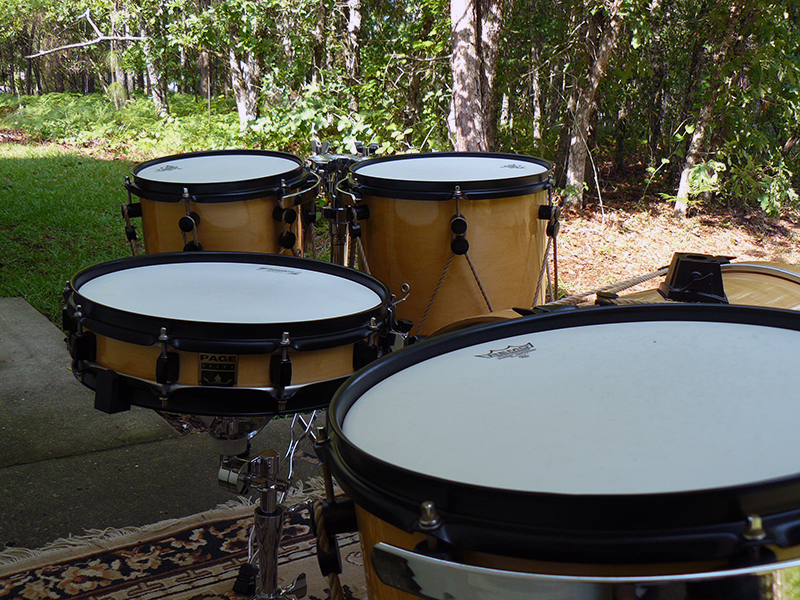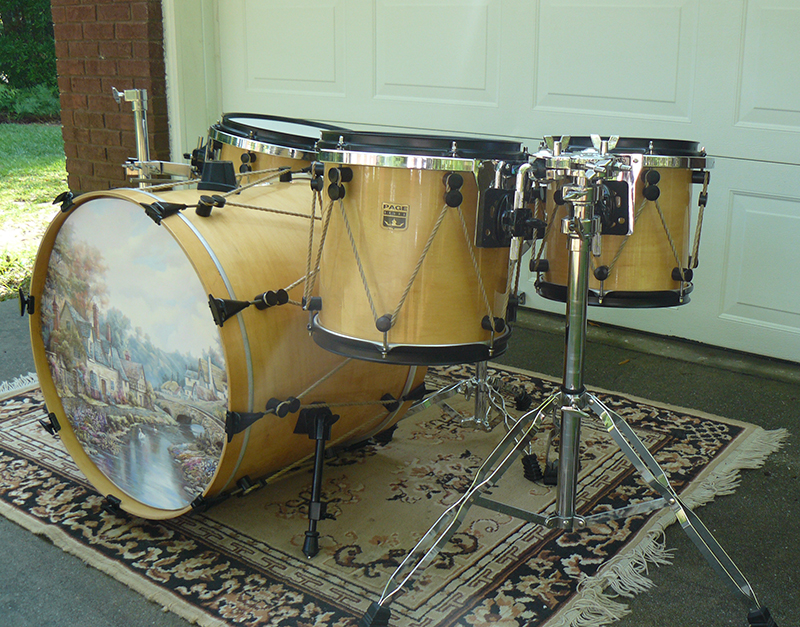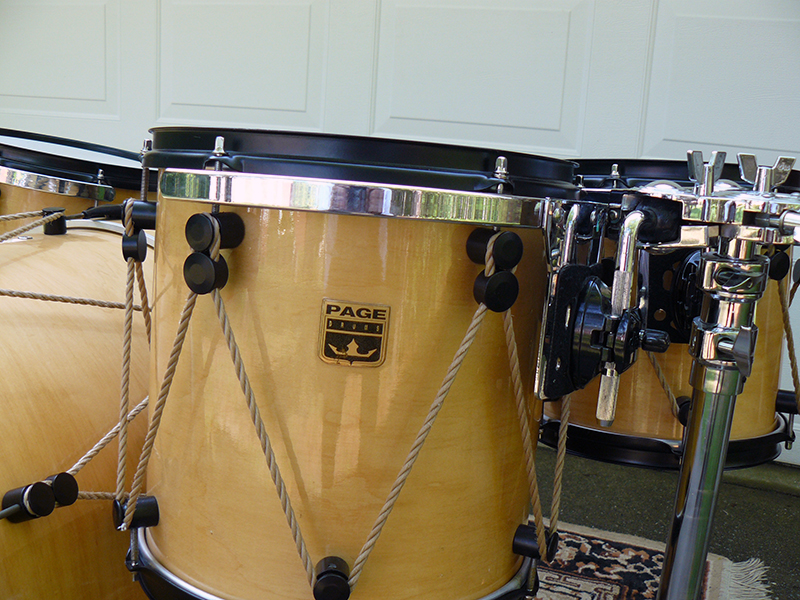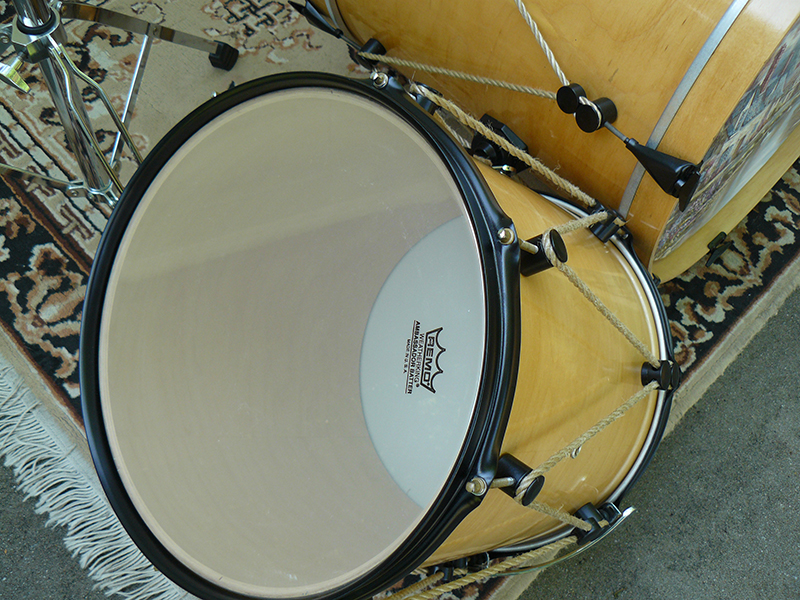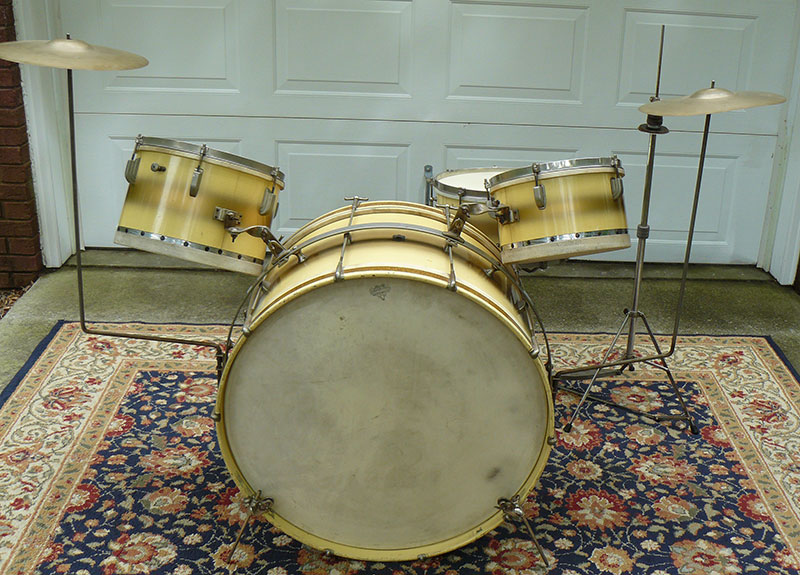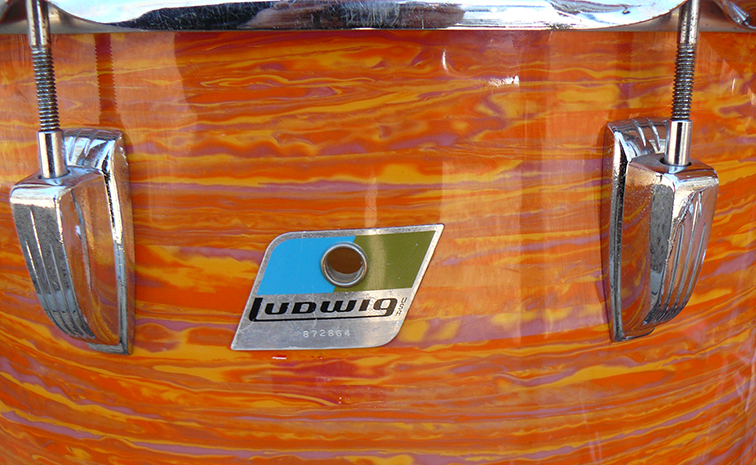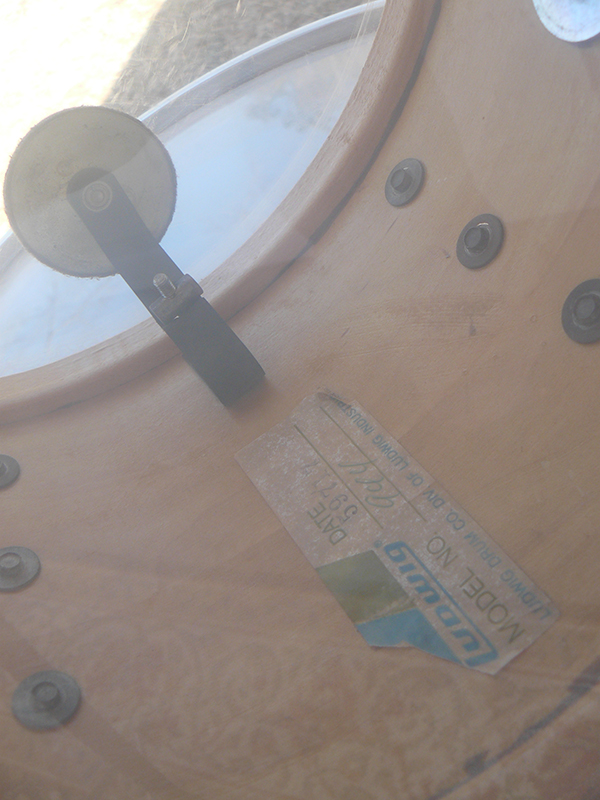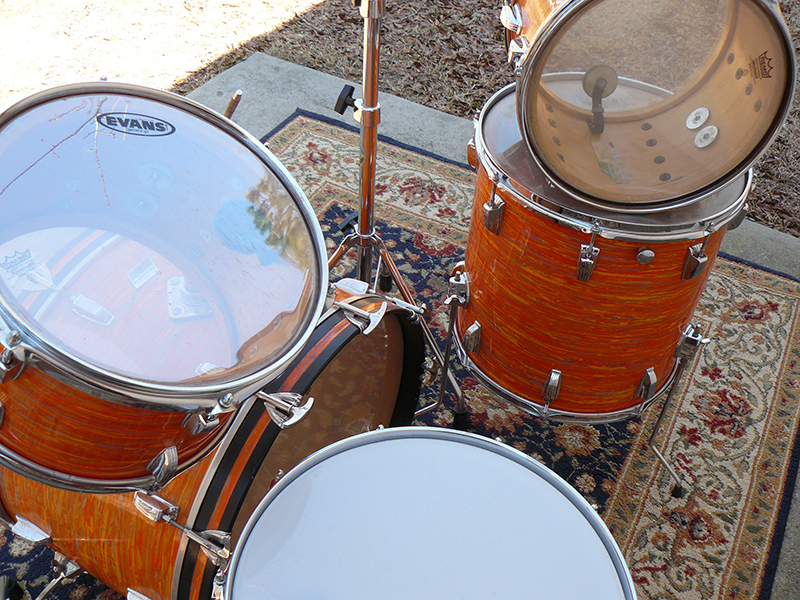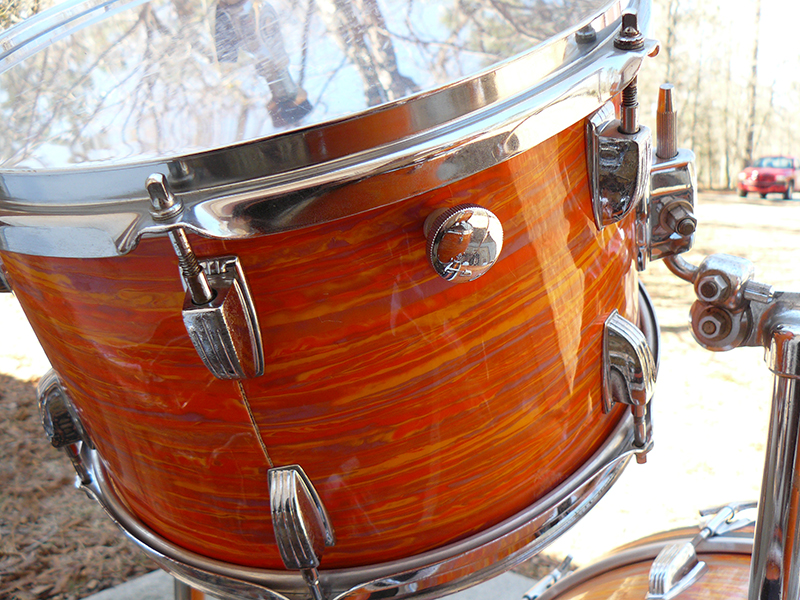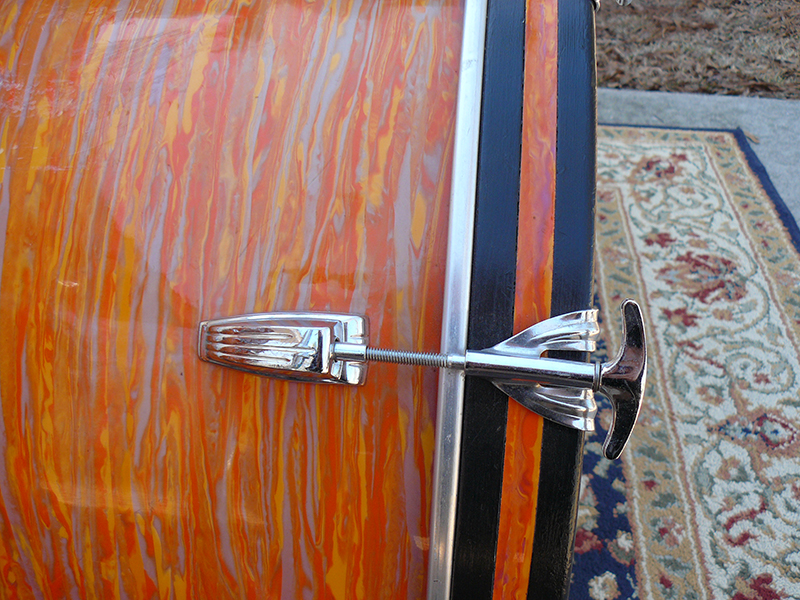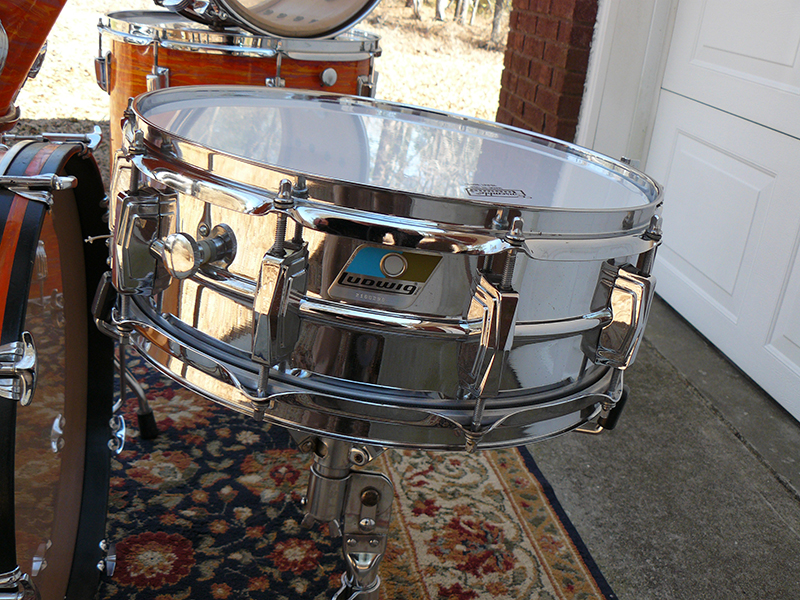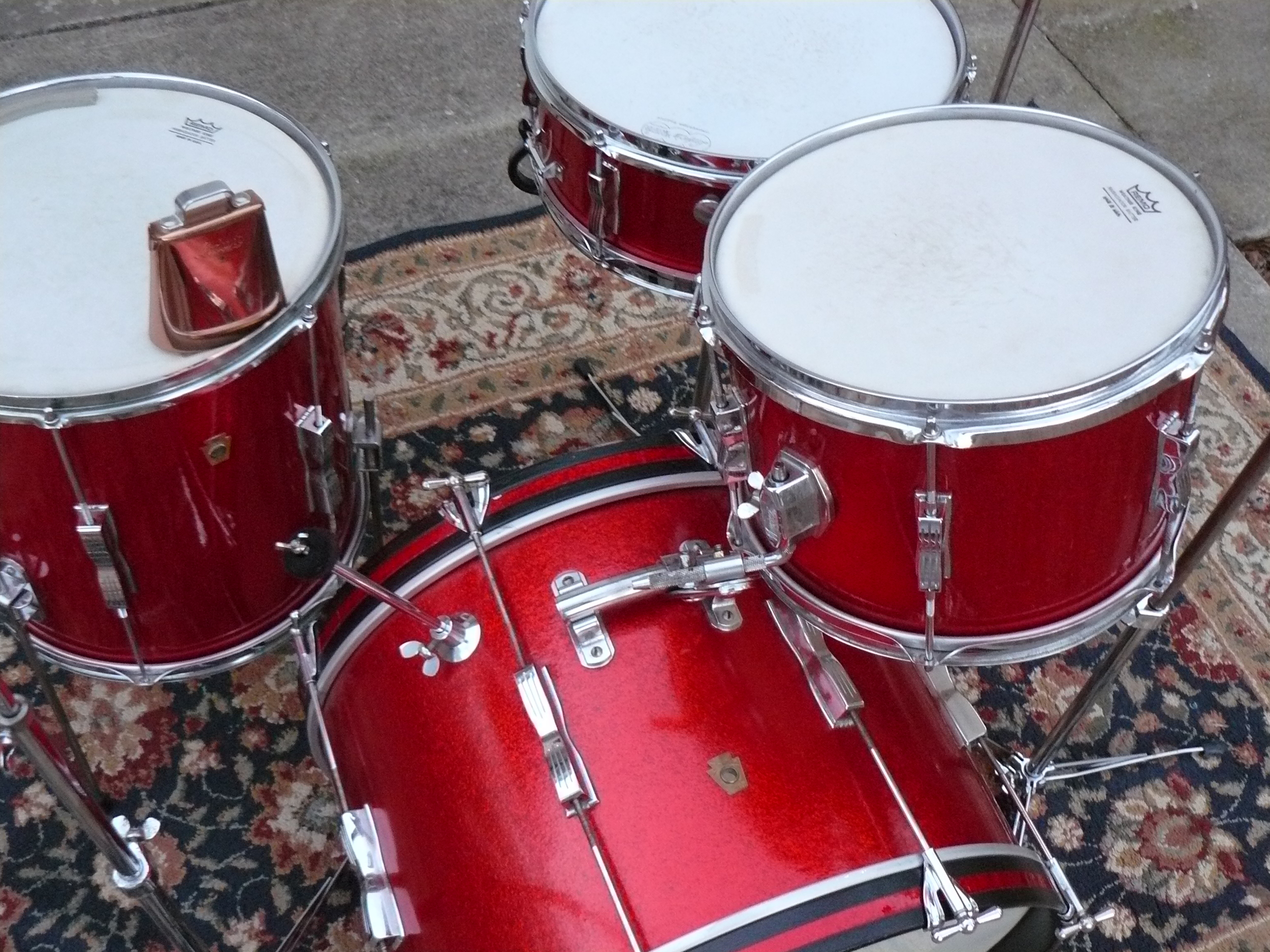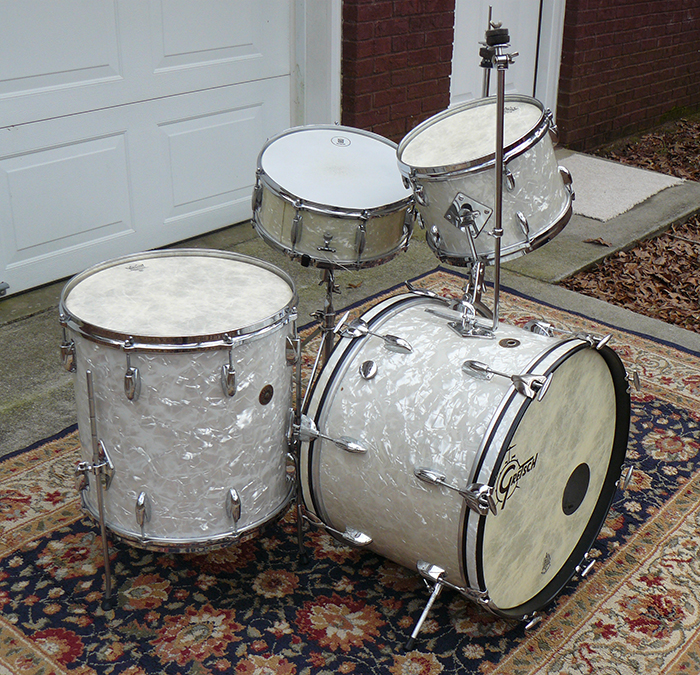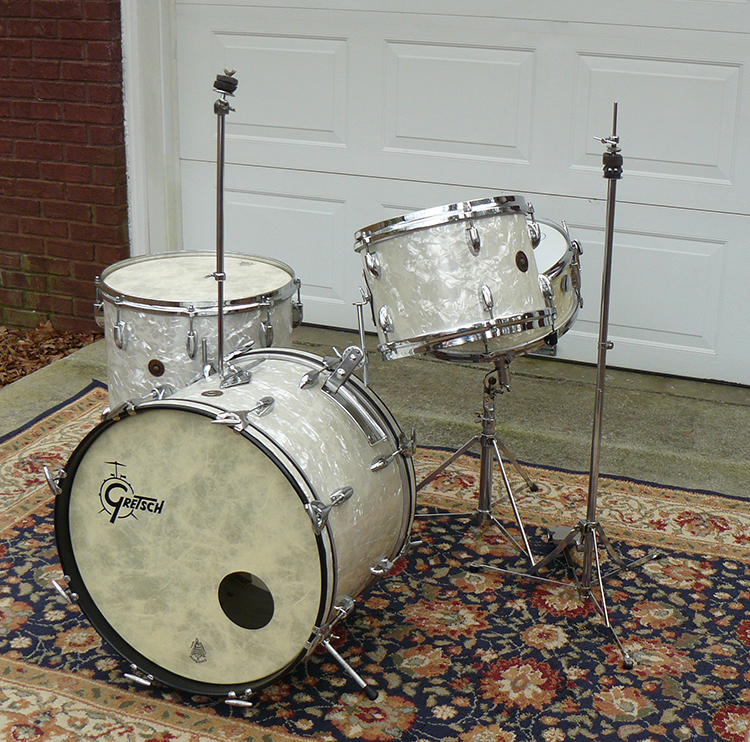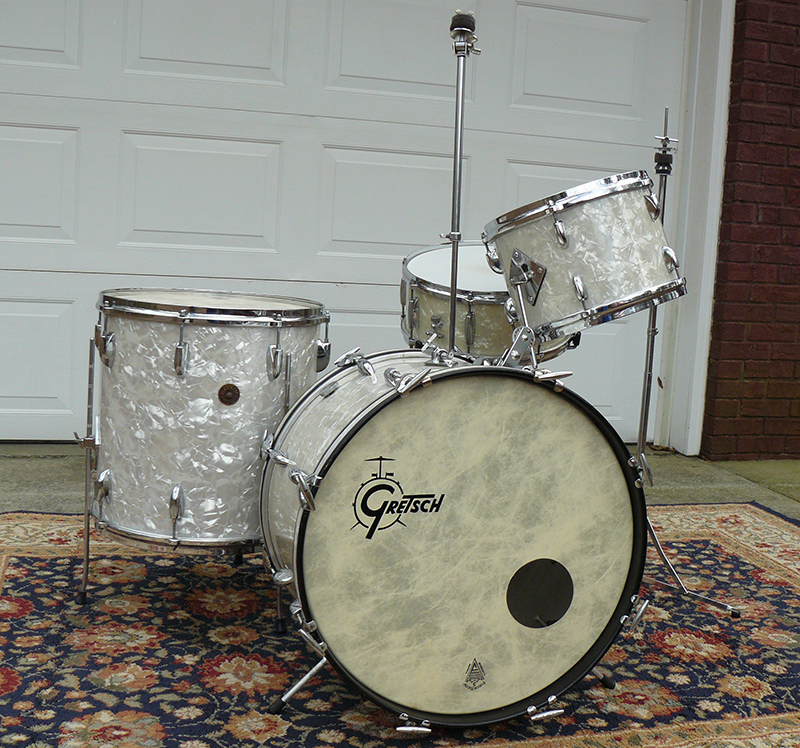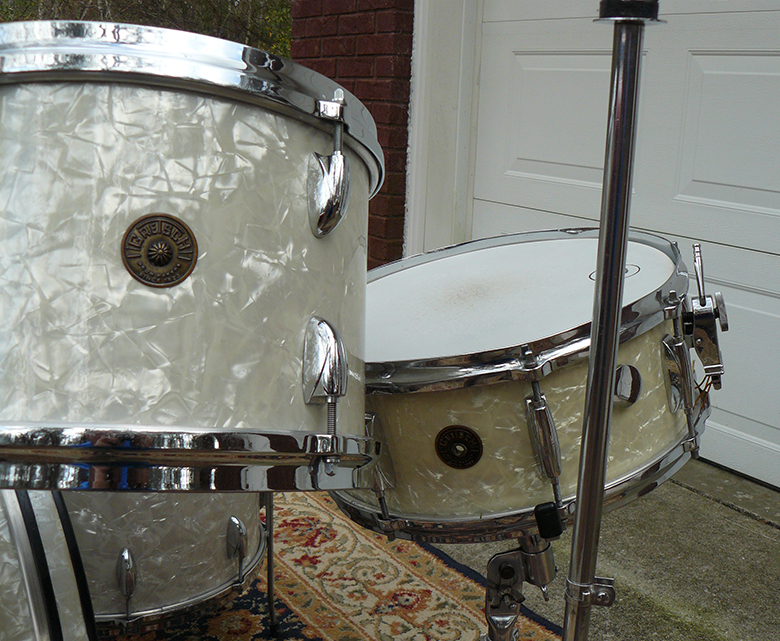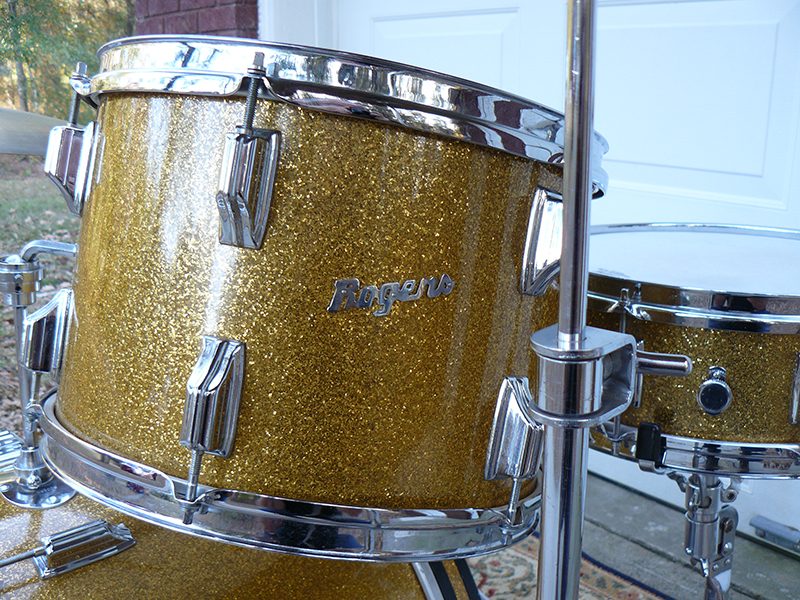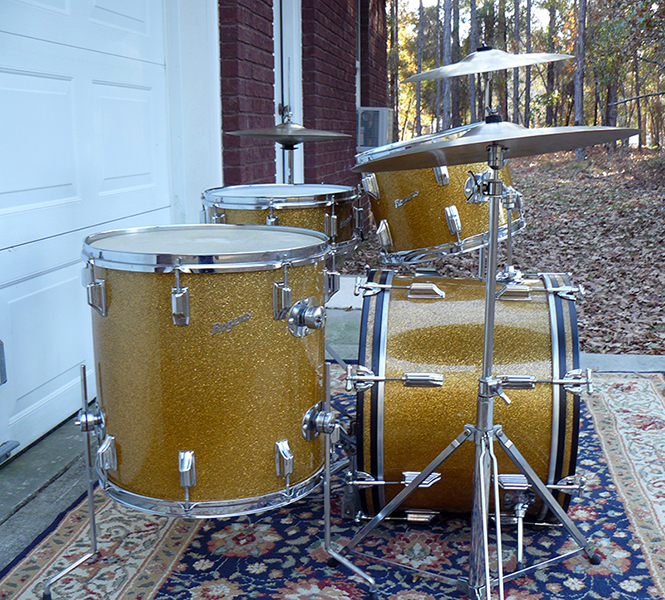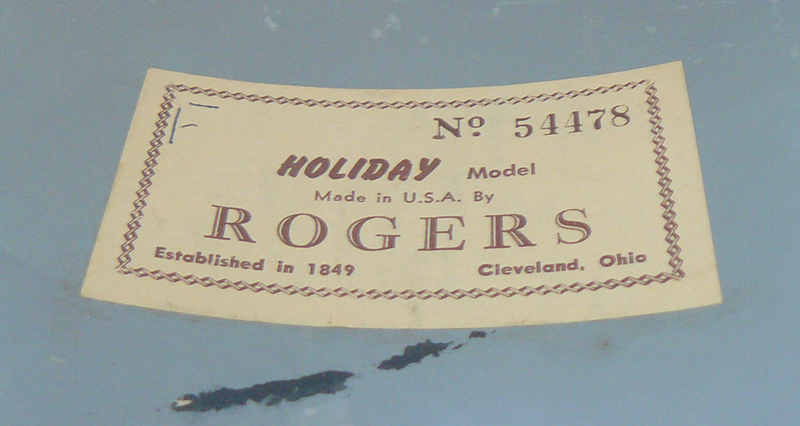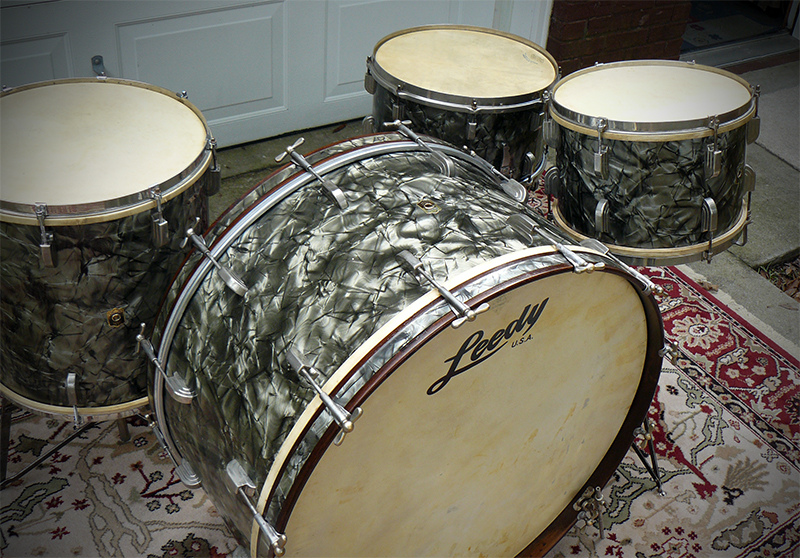Lately I have been bitten by the Camco bug. You might have been bitten by that bug yourself. There has been a rise in interest in these wonderful drums in recent times and I started wanting to own a Camco kit. I read the article about Camco drums here in the magazine with great interest. In the article the writer called them the "Stradivarius" of vintage drums. I have always thought they looked great, and wanted to own a set, so I finally made it a point to acquired a set for my collection. All the hype about these fine drums is true. They are very well built and sound fantastic. I think the first time I noticed them was when Dennis Wilson played a blue moire Camco set with the Beach Boys.
Read more1950s Leedy & Ludwig Broadway Set
I went in to the lovely home of the owner of this set. He is in his 80s, and after a few minutes of greeting I was taken to the set. It wasn't set up, but I was encouraged to set them up and play on them or whatever I wanted to do. I just enjoyed looking at everything. There was also a wonderful cymbal set included, some of them were "K" Zildjians. There were stands, other hardware, and a box full of great old percussion "stuff." After I had looked it all over, I sat down with the man and enjoyed a long talk with him. He has a life filled with great experiences and I'm glad I got to hear some of them. If I had left without the drums and only got to talk to this guy, I would still be richer from the experience.
Read more1990s Page Drums Custom Set
Hello vintage and custom drum friends,
It seems like Summer has made it, and it gets really hot here in Georgia, my home state. I am not going to complain after the long cold Winter we had. I'm sure some of you had a lot worse weather than us. We don't usually have freezing cold very much, but we had plenty of it this year. Enough talk about the weather, now we are going to talk drums. That's something all we drum fanatics like to talk about. The set from my collection I want to show you this month is a very cool 1990s Page Drums custom set. I first saw a set of these unusual drums on a television show. The show was called "Celtic Thunder". The musicians and singers were awesome to say the least, and the drummer was playing a set of these rope tension drums. I fell in love with the huge sound and the distinctively vintage look of the kit. I could easily see the large Page logo on his bass drum, so I started researching the drums and looking for a kit to buy.
The Page Drums were originally a product of a partnership of David Page and Jeff Hudson. Page Drums was a custom drum company from San Diego, California. This kit has a unique hemp rope tension design. 100 percent Keller 8 ply maple shells on toms and 10 ply on bass. The shells have no holes in them and the shells float between the 2 heads. These were billed as the most resonant drums on the planet.
The following comments were on the Page Drums web page:
"Each Page Drum is independently hand-crafted, made from the finest maple shells and hardware, stained or covered, and sized entirely to your specifications. The look of Page Drums is both classic, and uniquely your own. Originally introduced at the 1992 NAMM show, and twice nominated for "Best Acoustic Drum". Page Drums are the only totally resonant drum on the market. David Page has created a drum with absolutely no hardware attached or drilled into the shell. This concept completely eliminates any rattling or buzzing sounds."
The sizes of the drums are: bass drum 22"X18". Floor tom: 14"X14". Tom: 12"X12". Tom: 10"X10". The non free floating snare is a crackling 14"X3". The hardware is black powder coated. The tom Mounts are a combination of Rims mounts and Drum Workshop. The rope tension is very cool. The rope is pulled around the floating lugs with the tension rods loose. The rope is clamped in place and the tension rods are tightened to desired tightness. The extra part at the top floating lug is a sliding tension device like the ones that were on the old rope drums. The ropes are so tight the tension device will not slide down unless you leave the ropes very loose. The ropes will not tighten up "jazz" tight but will get fairly tight. Bottom and top heads tighten up together. The ropes can be replaced with cable to really crank them up. I love the look of the ropes though, and I don't plan to retrofit them with cables.
Jeff Hudson is now making these drums and calling them Hudson Custom Drums Los Angeles, California. He has a good website and facebook page. They are beautiful and very unique drums. Everyone that looks at my drums comments on this set.
In closing I'll just tell this little story about how I ended up getting this set. I had been looking for a set of Page Drums after seeing the "Celtic Thunder' show on Georgia Public television. I was browsing E-Bay just before going out to dinner. My wife was saying, "Let's go were going to be late," when I saw this set for sale. I could hardly believe it. They were just what I was looking for in the clear maple finish and everything, but there was only an hour left. I said, "Wait honey, I need to bid on this drum set." Let me tell you that set off a firestorm, and I had to work fast. The seller had a buy it now price, but it was high. There was also a make an offer option. I didn't want to lose them, but the thing is I never want to pay full price for anything. I made him an offer, turned off the computer and ran out the door. All through dinner I kept hoping he had accepted my offer. When I was finally able to get back to my computer I was pleased that he had accepted the offer. My wife accepts my "sickness" but she doesn't fully understand it.
If you have a set of Page or Hudson Drums please leave a comment. I would like to know what you think of them. Also, leave a comment if you have seen a set of these being used anywhere, or just leave a comment about anything. Sometimes I wonder if anyone is reading these articles.
Have a great Summer, Phil Wilson
Leedy 1940s Drum Set
Hello, vintage drum friends. I just love the old drums, and I'm sure many of you love them too. If you didn't you probably wouldn't be reading this magazine. There's just something special about the drums built in the 20s through the 40s. Most of the drums I own are from the 50's through the 70's. Those really appeal to me the most because those are the drums I grew up playing and wanting. The same is true of cars. I really dig the 50's through the 70's cars the most, but the pre 1950s cars are also very cool to me. Just like the really old cars with the big fenders, the really old drums have a special awesomeness about them. Those big bass drums and the sound of those old "tubs" give me goose bumps. I have a set to show you that I think has a great old vibe and I think you'll love them. It is a set made by the great Leedy Mfg. Company. They have a 1941 date inside. So they were built just before the United States entered into Word War II.
Leedy was one of the great American drum companies, and their drums were known for excellent quality. They were a very innovative drum company. The first drums they made were built in Indianapolis. The 20s were a wonderful time for the company. Leedy products were very popular. U.G. Leedy, the founder became sick and sold the company to Conn in 1929. The Leedy drums were made in Elkhart, Indiana beginning in the 30's. This kit has Elkhart badges. Throughout the 30s and 40s Leedy drums demonstrated American craftsmanship at its best. I recommend you read "Mr Leedy and The House of Wonder" by Harry Cangany for the story of the "World's Finest Drums".
This set is a matching four piece set in a beautiful Cream and gold Duco finish. More than likely painted by Mr. Ray Poland who worked in the finishing department for many years. I just love this finish. I wish I had the skill to paint drums like this. The sizes are: bass drum 26"X14", the small tom is "11X7", the large tom is"13X9", the matching Reliance Snare is "14X6.5". The toms have tacked calf bottom heads. The hardware is nickle plated. The toms have Beavertails on top with single flange rims and hooks. The bass drum has single tension with thumb rods. The rod passes through a bridge on the bass drum that matches the Beavertail lugs .The snare has 8 tube lugs, single flange rims with hooks, and the Presto strainer. These drums still sound great. They are a work of art as well as a great musical instrument. The metal mounting bar on the bass drum is very cool. All this metal was not allowed on the metal restricted war time drums that followed this set.
I went to buy a Ludwig Deluxe (Black Beauty) from a fellow collector. He was selling the snare for a well known recording and touring drummer. He showed me this Leedy reliance snare drum and told me the complete set was for sale if I was interested. I was unable to turn down the Leedy kit once I saw the snare drum. I ended up buying the Ludwig Deluxe and the Leedy set. I was very excited about the buying trip until I thought about how I was going to explain it to my wife. I surprised her once by coming home with a Rogers kit and a Slingerland kit we had not discussed. It took a while to explain to her what a great deal it was. Fortunately, she was very understanding, and she really liked the Leedy set. Who could resist loving a beautiful Leedy set like this? Until next time keep looking for those drum treasures.
1971 Ludwig Hollywood Mod Orange Set
Greetings vintage drum lovers and friends. I hope the Winter is on the way out and nicer warm weather is on the way in. I brought out a set out into the sunlight to show you that I try to keep in the dark as much as possible. It is a 1971 Ludwig Hollywood set covered with the rare Mod Orange wrap. The reason I keep them in the dark is to try to keep the color from fading even more than it already has. This color is one of the three Ludwig psychedelic wraps that caused quite a stir in the late 1960s and on into the 1970s. You have to be around 50 or older to understand why anything psychedelic was cool. The three psychedelic colors were, Psychedelic Red, Mod Orange, and Citrus Mod. These wraps are filled with color, but unfortunately they fade when exposed to sunlight. It is hard to find a set with these wraps on them that is not partially or severely faded.
My set is faded and has some cracks in the wrap and bumps and bruises. When you get a chance to own a Mod Orange set you will overlook a few flaws, because there are not that many sets out there to be had. The Reds are a little more plentiful. Ludwig did really well selling the Reds and then introduced the Oranges. The Oranges didn't sell as well as the Reds, even though John Densmore helped their sales by playing a set of Oranges with the Doors. The Doors were very cool, but you already know that. The Citrus Mods did even worse in sales than the Oranges and therefore they are even harder to find. A nice set of Citrus Mods will cost you big bucks.
The sizes of my Mod Orange kit is, bass drum 22"X14", the floor tom 16"X16", the toms are 13"X9" and 12"X8". The shells are three ply with reinforcement rings and clear coated inside. The white sealer paint inside the shells ended in the late 1960s. The toms have the rotary mute inside with the larger round handles outside the shell. The double tom mount is factory placed on the bass drum. There is a paper badge inside the shell that dates them to 1971. The Blue Olive badges are pointy on the corners which indicates early 1970s. The snare drum placed with the set is a 1970s 14"X5" chrome Supraphonic. It is very hard to find a wood shell Mod Orange snare. If you do you will pay a large ransom for it. Some Mod Orange snares have been recover jobs using a strip from a donor floor tom. Be careful when buying a Mod Orange snare drum.
Ludwig reintroduced the Mod Orange finish a few years back, but I think the results were about the same as the first time. I guess we will just have to say it's so ugly it's kinda pretty. You might still be able to purchase a version of this wrap if you would like to have this finish on a restoration job. Some have found Mod Orange wrapped drums that have been painted over. Can you imagine buying a pawn shop white painted Ludwig set and finding Mod Orange wrap underneath the paint. It will be difficult to remove the paint and not damage the finish. Get a professional to help you with that. Until next time, use cases and stop scratching up those future vintage kits, and keep searching for that Mod Orange Jazz Festival in somebody's yard sale.
Red Sparkle Ludwig Club Dates
These drums have a beautiful red sparkle finish as you can see in the photos. The sizes are typical for this era Club Dates. The bass drum is 20"X14", the floor tom is 14"X14", and the mounted tom is 12"X8". The snare with this set is a matching Pioneer 14"X5". Acrolite snares were offered with this kit beginning in 1966. There is cymbal mount on the bass drum that is factory placed near the batter head side pointing toward the floor tom. Also the small brass cowbell was featured with the set. They are light weight three ply shells with reinforcement rings. The unique characteristic about these drums is the center shell mounted "bowtie" lugs. Dual tension is achieved by long tension rods. The shells are painted white inside and have Keystone badges. The floor tom has "clipper" legs. The legs are straight and the holders are spring loaded with a push button adjustment. The mounted tom is attached to the bass drum by the "old faithful" rail type single tom holder.
Now the story. I was talking to a fellow drummer who told me he had just bought a new Tama drum set. I asked him what he had done with his old set? He said, "they are really old, in pretty bad shape, and they are beginner Ludwigs." I of course inquired about the "old, bad shape, Ludwigs." He told me I could come over and see if I wanted them. I asked him if right now would be too soon. If possible, go the minute you hear about a set, because things can happen so quickly and you will lose your chance.
He had let them get in very poor shape. They had no resonant heads or hardware, also missing were the front hoop and rods on the bass drum. A screw driver was employed as a bass drum leg. 30 years of dirt and grime was coating everything. I asked him," how much will you give me to take them away". He was mildy amused, and then said, I'll take $50.00 for them". Without haggling I gladly paid and loaded them up.
I spent a good bit of time and money putting them back in shape, but they are worth it. I even got some flat base hardware with the deal.My friend, Butch Braddy, drum dealer at a popular Georgia music store chain was asked to provide some authentic vintage drums to be featured in a movie. Savannah, Georgia has become a favorite spot for many movie makers to shoot films. Butch and I provided the drum sets for the movie about the CBGB Club in New York where many famous bands made their debut. This set is in the film. I haven't actually seen the film yet, but I did watch the trailer, and can't wait to see these Club Dates in their starring role.
Keep looking for those great vintage drum deals.
Phil Wilson's 1950s Gretsch Set
Greetings vintage drum lovers,
Old man winter has finally made it. It's probably cold where you are and probably you are getting some of the "white" stuff around your home or business. Being from Georgia, we hardly ever get snow, but I like "white" drums falling into my lap.
I bought this wonderful white pearl 1950s Gretsch set a while back from a man who brought them right to my door from New York. I'll tell you more about how I was lucky enough to get them after I describe them.
I believe this set is from the late 1950s because I have been studying up on them in "The Gretsch Drum Book" by Rob Cook and John Sheridan. If you don't have this book you need it. It is a great source of information about everything Gretsch. The shells are heavy three ply with silver sealer inside that dates them in the late 1950s. There are no orange labels inside that started in the early 1960s. The round badges were used from the 1930s through the 1960s. These "round badge" Gretsch drums are very collectible. They are also great sounding drums. The sizes of these drums are bass 20"X14", the ride tom is 12"X8", the floor tom is "16X16". The matching snare is 14"X5". The snare has the Micro-Sensitive strainer. There is a diamond plate cymbal mount on the top center of the bass drum. The distinctively Gretsch bass drum T-rods have been used since 1958. Another cool feature is the long lip extension rod to raise the tom tom.
One good thing about having my name out there as a collector is I get calls when someone wants to sell a vintage drum set. I can't buy them all, but I try to give advice to everyone who calls or E-mails me. A man from New York E-mailed me to try to get some advice about this drum set. He had no idea they were valuable. He had listed them on Craig's list trying to trade them for a Kayak. He said he had twenty responses all wanting to buy him a Kayak and get these drums. He ask me if I wanted to buy them. He told me I was his second call. He had already called a very well known drum seller. This drum seller is a friend of mine, and he had given him a dollar amount that he felt they were worth. I ask him if my friend had offered to give him that much. He said well,no, but he said "that's what they are worth." I said," they are only worth what someone will give you for them." He laughed and asked if I would like to see them. He said that he and his family rode right by my town going to Florida for vacation, and he would bring them if I wanted them.
I was very excited when he arrived at my door and we unloaded this set. It was very dirty and needed a lot of love and attention, but I could tell it was a very desirable set. I made him an offer of cash and he accepted it. He said,"I have another old drum I want to give you". He reached under the seat and pulled out a 1960s Keystone badge Ludwig Supersensitive. It was in excellent condition. That was just a bonus to the deal. I was smiling when he left.
Every now and then do a roll, Phil Wilson
The Rogers Holiday Set
Holiday Greetings,
It's the Holiday season, and I have a great Holiday drum set to show you this month. Rogers drums are very cool and so collectible. I am always on the search for a nice Rogers set, and love the history of this great drum company. In the beginning this company was a drum head manufacturer. Rogers became the makers of some of the best drums ever made. By the time this featured drum set was made, Rogers drums were the most expensive of all their competitors.
I will tell you how I came to own this set after I describe them. They have script badges. There is a script badge on both sides of the mounted tom. The shells are maple with reinforcement rings. The lugs are Beavertails. The Beavertail lugs were a great improvement over the Bread and Butter lugs which would crack very easily. The Swiv-o-matic tom mount is factory placed in the center of the bass drum. The floor tom has a factory extra knobby. The bass drum is 20"X14", the floor tom is 16"X16", the ride tom is a 13"X9" and the snare is a matching 14"X5" Powertone. The finish is a vibrant gold sparkle. The interiors of the drums are painted solid grey. That indicates that they are early 1960s. The tags inside indicate that they are Holiday Model drums. The Cleveland tag means the drums were warehoused and sold from Cleveland. After CBS bought the company in 1966 warehousing was moved to Dayton. All these drums were made at Covington, Ohio. The Dayton drums have grey speckled interiors. There is no difference in the quality of pre-CBS and post-CBS drums made in Ohio. The factory was later moved to Fullerton, California.
The drum salesman at the music store gave me the number of the man who was selling some Rogers drums. He said he had several Rogers sets and wanted to sell some of them. We set up a time that I could come to see the drums and hopefully get a set. When my wife and I got to his home it was very upscale. To make a long story short, he took us to a room filled with beautiful Rogers drums. There were red onyx, grey ripple, and other beautiful kits in there. I soon learned that none of these sets were for sale. He took us to a cabinet where there were five Powertone snares displayed. White pearl, blue sparkle, gold sparkle, red sparkle, and I'm not sure about the last one. I think it was black diamond.
The guy said he had the full kits to match each of these snares and everything is in pristine condition. I said “great! Let's see them”. He said, “Which one?”. This was most unusual for me. I wanted to see them all, but I could tell he really didn't want to drag out all those drums, so I said “Let's see the white ones”. He said, “Follow me” and we went downstairs and into a closet. He pulled out a case then two. Inside were the tom toms and they were very nice. I said, “You know, I would like to see the blue ones too”. He put the toms back in the case, put them back in the closet, and said, “Follow me” again. I began to feel like if I wanted to go to the next one there was no turning back. My wife was still in the big drum room and I was going on the hunt through the house with the owner. We got to the blue ones, also in a little room in cases. It was the same as before. “Do you want these?” “I would like to see the gold ones.” He packed everything back up and led me away to another room. By this time I was getting concerned about my wife, and I began to think I better pick one or else I would lose my chance. When I saw the gold ones - this set I'm showing you - I said “that's it!.” He was pleased that I didn't have to see them all. We made a deal and I loaded them up. It was really a fun experience.
I hope you have a safe and enjoyable holiday season. Keep looking for those great attic finds.
Later, Phil Wilson
The 1941 Leedy Set
HELLO AND HAPPY FALL!
The air is cooling down and the leaves are beginning to change colors. It's time to put away the summer clothes and get out the long sleeves and sweaters. I have a very "cool" old drum kit to show you this month. I know I featured a black diamond kit last time, but this black diamond set has "greened" a little giving it a completely different look. The set I want to show you is a 1941 Leedy. I have all five pieces. It was bought as a set in the year they were made and was owned by one gentleman until his death a few years ago. The man played this set with an orchestra until he purchased a Ludwig set in the 1960s. He put this set away in storage and that's where it stayed until his son decided it was time to find a new owner.
I'll tell you more about how I was fortunate enough to acquire them later. The sizes are: bass drum 28"X14", toms 16"X16", 13"X9", and 12"X8". The matching Broadway Parallel snare is 14"X8". The shells are plies with re-rings. The lugs are Beavertails introduced in the late 1930's. The insides of the bass drum and snare are painted white like Ludwig. Conn owned both Ludwig and Leedy when these drums were made. They were made side by side and yet maintained differences. Conn finally joined the two lines in the 1950s and made Leedy Ludwig Drums. The Ludwigs bought the Ludwig line back in the mid 1950s and Slingerland bought the Leedy line. You already know all this, I'm sure.
These drums were made in Elkhart, Indiana. The workmanship is excellent. The date stamp inside is January 1941. That was just months before Japan bombed Pearl Harbor bringing the United States into the World War.
The mark inside also says "For Pearl". This means the shells were marked for a pearl wrap finish. The black diamond finish still looks very good although age has made it look sort of green. The hardware is nickel. The heads are calf with the exception of the bass drum batter head.
The son called me and told me he had gotten my number at the music store. He asked me if I would be interested in a very old Leedy drum set. After catching my breath, I calmly said, "sure, when can I come see them." Never say what do you have unless it's a very long drive. My wife went with me, and there they were all spread out on the garage floor. He said the head with orchestra name and his Father's shield logo had been destroyed. The mounts were gone and some of the rods and clips. He gave me a great deal , because he was tired of storing them. It was very exciting to load them up. I have enjoyed the clean-up and having the great piece of history in my collection. Oh, What about the Ludwigs?, some of you are thinking. He said his step-mom had disposed of them and I could tell it was not a subject I wanted to pursue.
Until next time, Phil Wilson

